What Is A Heating Core And How Does It Help Bake Better Cakes?
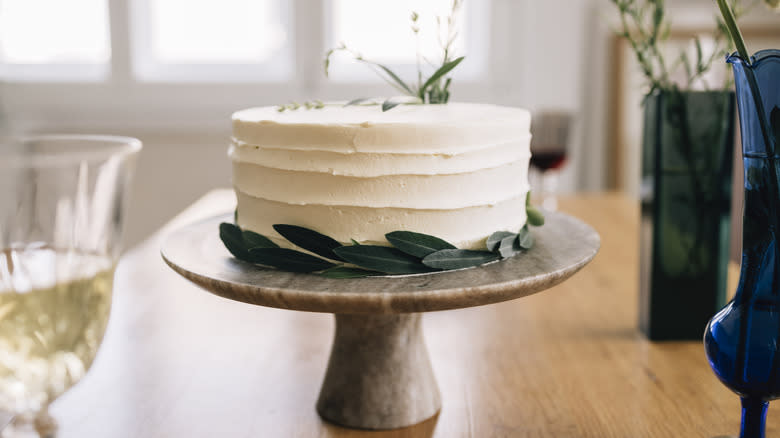
Heat needs time to work its way into any piece of food; that's just physics. Sometimes this works in your favor as a cook or baker: It's how you get a nicely charred crust on an otherwise rare steak, for instance. In cake baking on the other hand it's a definite issue, and most of us have watched irritably as a cake overbakes at the edges while remaining gooey in the middle.
Weirdly, a simple piece of metal can help even things out. It's what professional bakers know as a heating core, or sometimes a heating rod. I trained as a chef, not as a baker, but I've baked commercially on a small scale and have been an active home baker for over 40 years. So pour yourself a cup of coffee, and take a seat. I'll explain what heating cores are, how they work, and how you can improvise your own if you need to. More importantly, I'll explain how they can help you bake better cakes (and even improve your cooking in some cases).
Read more: 30 Types Of Cake, Explained
What Problems Are Caused By Uneven Cooking Or Baking?

Heat enters your food through conduction, convection, or radiation. Heat transferring from the pan is conduction. Heat from hot, moving air is called convection; whether it's the natural circulation of air in a conventional oven or the fan-driven air of a convection oven. Radiation is what you get from the glow of the actual element or coals; it's why your cakes will brown too much if the element is on constantly.
Conduction from a metal pan works faster than convection from the oven's air, which is why your cake begins to set at the edges before it's fully baked in the middle. It's why cakes become rounded or "domed" in the middle, and often need leveling before you can decorate them. Darker pans are worse for this, so the color of your cake panreally does matter. This is also sometimes why cakes fall: They aren't fully set in the middle when they come out of the oven and collapse as they cool.
The same principle applies to other things cooked in your oven, including savory dishes such as casseroles or quiches. It's an issue most of us encountered eventually; one of the biggest mistakes everyone makes with quiche is pulling it out before it's properly baked (or, for that matter, after it's over-baked).
How Can I Make My Foods Cook Or Bake More Evenly?
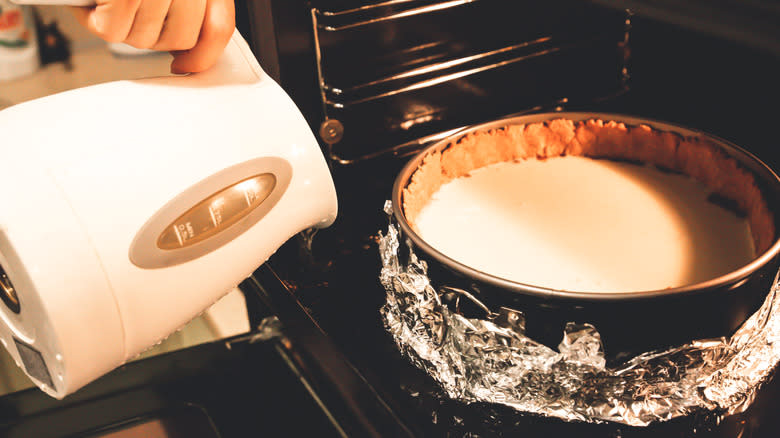
Bakers are a creative and resourceful bunch. Accordingly, we've come up with a number of ways to compensate for this inconvenient bit of physics (or more specifically, thermodynamics). One is to make a shallow hollow in the top of your batter, to counter its rise when baking, and leave you with perfectly flat cake tops. Removing the problematic, slow-cooking middle also works: That's how we ended up with ring-shaped donuts and bagels, as well as angel food and Bundt pans with their central chimneys.You can also slow heat transfer from the pan itself. That's why professionals bake cheesecakes in a water bath, for instance, and why we favor light-colored natural aluminum for commercial pans. Home bakers can buy insulating strips to wrap around their pans, from Wilton or other baking-supplies vendors. A final option — the one we'll look at in detail — is to harness the physics of heat transfer, changing it from a problem to a solution. That's what heating cores do.
What Is A Heating Core?

The idea behind heating cores is pretty simple. The second law of thermodynamics says that thermal energy always moves from where it's warm to where it's cool. Metals are excellent conductors of heat, much more so than wet, sloppy cake batters. So a heating core is simply a piece of food-safe metal that conducts heat from the oven's air into the slow-baking center of your cakes. If you are making oversized or extra-deep cakes, which take longer to bake fully, we find they can spell the difference between success and failure (personal experience included).
Depending on the cake and your personal preferences, you might use a heating core alone or in conjunction with other techniques like the make-a-well hack, or you can also wrap your cake pan with some insulating strips. They all can help if you want flat, evenly-baked cakes (which, don't we all?).
The Kinds Of Heating Cores There Are
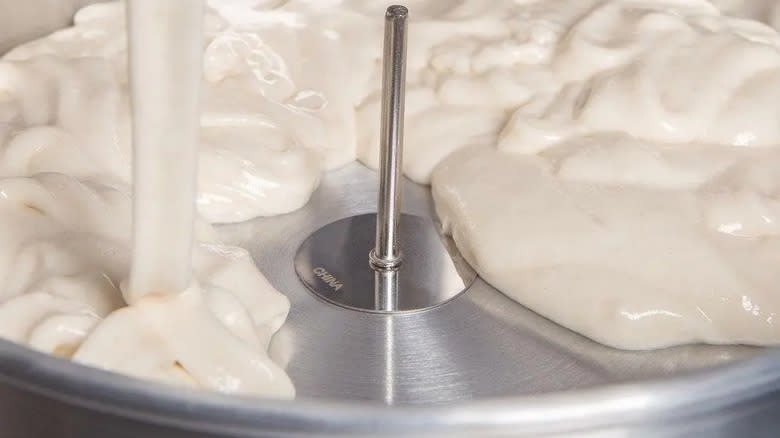
Heating cores come in two distinct styles. One is a sort of blunt-topped cone, rather like the tube in the middle of an angel food pan or Bundt pan. They're a few inches high and vaguely funnel-shaped. The other kind looks like an oversized nail or thumbtack, with a big flat head and a skinny nail-like body. The kind is sometimes called a heating rod, rather than a heating core.
The large kind transfers heat quite efficiently because they're made of aluminum — a great conductor of heat — like many baking pans. The flared top exposes more surface area to gather the oven's heat and conduct it into the cake. The smaller rod types, like the ones from Ateco, work on the same basic principle. The broad head of the "nail" absorbs the oven's heat, and then routes it into your batter through the rod.
How Do You Use A Cone-Shaped Heating Core?

Cone-shaped heating cores are just a very small baking pan, if you think about it, so treat them accordingly. That means greasing and flouring the core inside and out, since both sides will come into contact with your batter and may otherwise stick.
The next step is to half-fill the heating core with batter and set it in the middle of your pan. Pour the rest of your batter carefully around the heating core and smooth it into place, re-centering the core if necessary, and then bake normally. Watch the cake closely for doneness, because it'll bake slightly faster than usual (that's the whole point). Start testing it a few minutes earlier than the recipe suggests.
Once the cake has cooled, remove the baking core and pop out the little "plug" of cake from inside it. Set this piece into the hole left in your cake by the heating core, and if necessary trim it until it's level with the top of the cake. That's it. The small circle from the heating core won't be visible anymore once you frost and layer your cake, and we find it's usually all but undetectable when you serve the cake.
How To Use Heating Rods

Heating rods are simpler because there's no large divot to be replaced after you bake your cake. We find they're easier to use because they're relatively small and have no tricky interior surfaces or corners to grease and flour. A quick spritz with pan spray will usually do the job unless your recipe is extra gooey or has sticky add-ins. In that case, it's sometimes safer to go old-school with grease and flour.
Prepare your pan as called for in your recipe, with grease and flour, pan spray, or parchment paper (or any combination of those). Next, invert a heating rod so its big, flat head is centered in the bottom of your pan. Pour the batter around the heating rod and spread it evenly, re-centering the rod if necessary. Bake and cool the cake as usual, then turn it out of the pan. Slide a fingernail or the tip of a knife under the broad head of the heating rod, and pull it straight out of the cake.
Which Is Better, The Cone Type Or The Rod Type?
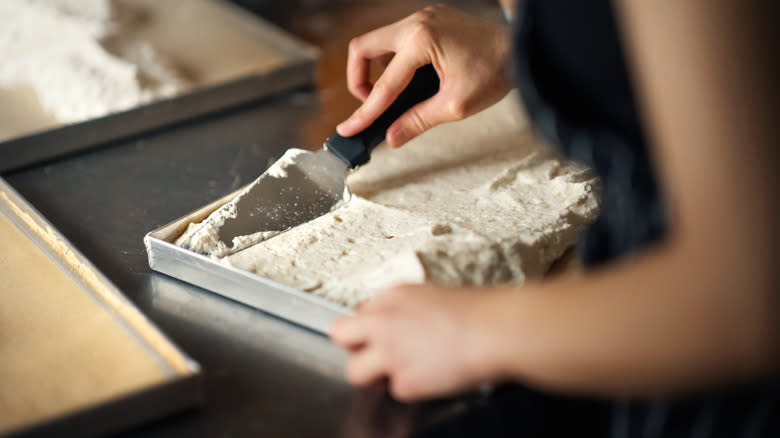
Both types of heating cores are effective, and each has its own advantages. In our opinion, your choice will usually come down to personal preference. The cone type transfers more heat into your cake, because of its greater surface area, but it needs to be carefully greased and floured. Otherwise, the small cake plug may not release easily after baking, meaning you risk it crumbling to unusable pieces when you remove it (we learned this the hard way).
The rod type is physically smaller, so it's more convenient to store when not in use. It's easier to remove from the cake after baking and doesn't leave a large hole to fill. The small hole it does leave won't usually be noticeable at all once the cake is finished and decorated. Both types are available in your choice of aluminum — a better conductor — or stainless steel, which is more durable.
We find either type of heating core useful when baking a cake that's more than 9 inches in diameter, or for specialized cake pans 3 inches or greater in depth. Other bakers may offer slightly different advice, but it's a reasonable guideline. You may also find that in pans 12 inches and larger, or big rectangular sheet pans, you'll get better results by using two or even three heating cores spaced evenly across the pan.
Can I DIY A Heating Core, Instead Of Buying One?

Some of us love all the gadgets, while others avoid single-purpose tools (Alton Brown famously rails against these "unitaskers," though in fairness some unitaskers are worth it). If you lean more toward the second camp or could use a heating core right this minute, you don't need to rush out and buy one. You can easily improvise one as needed.
All you need is something clean, made of food-grade metal, that's easy to clean after baking. If you already own a high-sided cookie or biscuit cutter, those are nearly ideal. Just grease and flour one, and put it into the middle of your cake pan. A steel timbale (a very small cup, like a shot glass) would work, and in fact it's much like an actual healing core. If you bake frequently enough to own cake decorator's flower nails, those are very similar to a heating rod. We use those ourselves in home baking, and they do an excellent job of helping our cakes bake more evenly.
If all else fails, use aluminum foil. Twist a sheet of foil into a cone shape, grease it, place it in the middle of your pan, and smooth the batter around it. After you cool your cake and turn it out of the pan, you can remove the cone from the cake. It will leave a small hole, but you can hide that with frosting.
Are Heating Cores Just For Cakes?

We've mostly talked about cakes up to this point, but heating cores aren't limited to oversized or extra deep sheet cakes and layer cakes. If there are any other baked goods that you find problematic, a heating core might potentially be a solution.
With brownies, for example, the best recipes walk a fine line between nicely gooey and just plain under-baked and doughy. A heating core in the middle of your pan can help keep you on the correct side of that equation. Similarly, some of the finest gingerbread recipes make a soft, delicate, almost pudding-like cake, and they can also be difficult to get just right.
Custardy pies are another common problem for bakers: Many of us remember the feeling of waiting, seemingly forever, for our first pumpkin pie to be fully set. A heating core can speed that process, too. We suggest the rod type for that use; because we find the small hole it leaves behind in the soft filling is easily concealed with a dollop of whipped cream.
Are Heating Cores Just For Baked Goods?
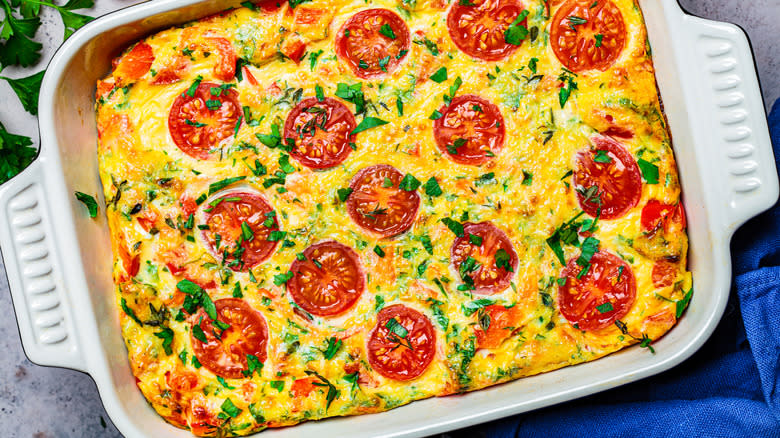
Physics doesn't care if foods are sweet or savory. Although they're made and marketed for bakers, heating cores can help your cooking just as much as they do your baking. Obviously, heating cores aren't appropriate for every dish, or every cooking method. Your best bets are things that cook in the oven, as baked goods do and have similar issues with uneven cooking. Picture dishes like casseroles, or old-fashioned scalloped potatoes, for example. Dark, crusty edges are more acceptable in those, up to a point, but ideally, you still want the middle baked before the outer edges are well and truly overdone. Just remember you don't usually turn those out of the pan as you would with a cake, so heating rods should be inserted from above if possible (if not, just slice around them when serving).
Savory or brunch versions of many sweet baked goods are prime candidates for a heating core. A French toast casserole or savory bacon, mushroom, and potato strata, for example, is very similar to a regular bread pudding that you'd serve for dessert. Similarly, a quiche is, at the bottom, just another kind of custard-based pie that can benefit from a heating rod.
Any Disadvantages To Using Heating Cores

After reading a couple of thousand words of praise for heating cores, you may wonder whether they have any negatives to offset their advantages. Nothing in this world is perfect, after all, and — yes — there are a few potential downsides.
For one thing, because they speed up the cooking or baking process, we find we need to keep closer tabs on our baked goods lest we accidentally over-bake them. Also, removing the core or rod will unavoidably mar the appearance of the finished recipe at least a little. We can usually conceal the evidence under frosting, or a sauce, or a garnish, but it's there.
A subtler drawback is that heating cores are one more lightly used gadget to keep around the kitchen. Storing them safely between uses, and then finding them again when they're wanted, can be an issue. We don't personally know anyone who complains of their kitchen being too large, too well-organized, or having too much storage, so those are important considerations. Ultimately you may decide to improvise a heating core when you need one, or simply bite the bullet and buy one or two. Either way, they're a worthwhile addition to any baker's kitchen.
Read the original article on Tasting Table.

